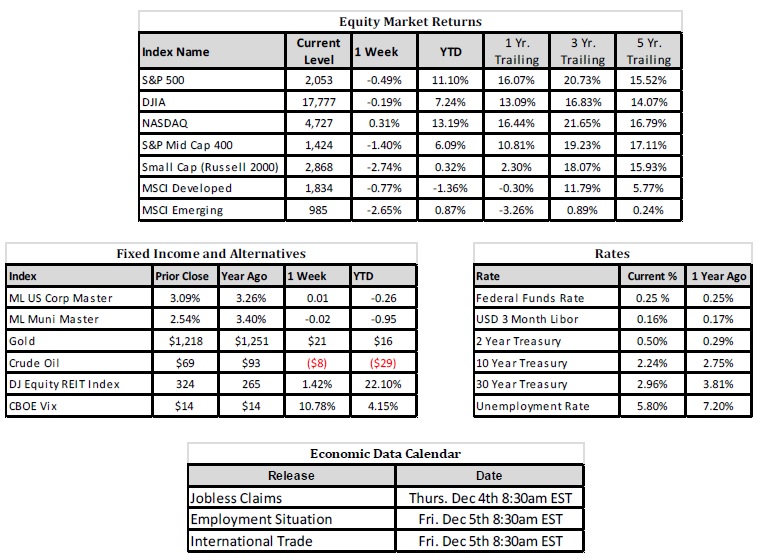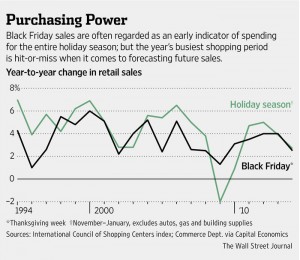
Capital Markets Update – Week of 12/1/2014
Market Overview
Sources: Rates Data and Economic Calendar—Bloomberg Markets as of 12/02/14; Equity Market Returns and Fixed Income and Alternatives Data—Wells Fargo Advisers as of 12/01/14.
Happening Now
Black Friday and the 2014 Shopping Season
Last week as shoppers prepared for Thanksgiving and Black Friday, U.S. GDP was released and was revised higher by 40bps to read 3.9% for the third quarter of 2014 (read the full report here). This positive economic news comes at a time when gas is currently cheap at the pump and the labor market continues to moderately improve. While these conditions should help spur consumption, the consumer confidence survey for November was actually the lowest since June. Despite this reading, according to Lynn Franco of the The Conference Board, income expectations were “virtually unchanged” (read the full article here). This all leads up to an extended holiday shopping season that is two days longer than last year’s because of the way Thanksgiving falls.
The initial Black Friday figures that were released from the National Retail Federation showed sales were down 11% from last year which caused consumer discretionary stocks, as represented by the ETF, XLY in this case, to lose 1.1% in Monday’s trading. Some retail analysts, however, suggest that it’s inappropriate to look only at Friday’s sales when analyzing what ultimately proved to be a week’s worth of online and retail discounts. Jay Henderson from IBM is quoted in a December 2nd Bloomberg article saying, “It’s not like the day isn’t growing, it’s just that the additional growth is being spread more evenly on other days” (read full article here). While strong Black Friday sales are often celebrated and regarded as a bell-weather for the holiday shopping season, it’s not always a simple relationship. The Wall Street Journal recently spoke with Paul Dales of Capital Economics who provided them with the chart below: (click here for the full article)
You can see that not only does the relationship between sales on Black Friday and sales during the overall Holiday Season move in different directions some years, the degree of movement (when the trends are matched) is imperfectly correlated. This means that not only does Black Friday offer an inconsistent predictive ability but considering the increased competition spurred by online retailers, deals continue to get more and more competitive, forcing businesses to potentially sell items below their cost. This ultimately weighs on their profit margins.
Finally, with U.S. markets trading at all-time highs, it is unfortunate to hear that some individual investors have remained on the sidelines in low yielding money market accounts despite their objectives of long-term capital appreciation. This is often a behavioral side effect associated with the decreased risk appetite of investors following a significant market correction, such as the one seen in 2008.
Important Information and Disclaimers
Past Performance is not a guarantee of future performance.
Investing in foreign securities presents certain risks not associated with domestic investments, such as currency fluctuation, political and economic instability, and different accounting standards. This may result in greater share price volatility. These risks are heightened in emerging markets.
There are special risks associated with an investment in real estate, including credit risk, interest rate fluctuations and the impact of varied economic conditions. Distributions from REIT investments are taxed at the owner’s tax bracket.
The prices of small company and mid cap stocks are generally more volatile than large company stocks. They often involve higher risks because smaller companies may lack the management expertise, financial resources, product diversification and competitive strengths to endure adverse economic conditions.
Investing in commodities is not suitable for all investors. Exposure to the commodities markets may subject an investment to greater share price volatility than an investment in traditional equity or debt securities. Investments in commodities may be affected by changes in overall market movements, commodity index volatility, changes in interest rates or factors affecting a particular industry or commodity.
Products that invest in commodities may employ more complex strategies which may expose investors to additional risks.
Investing in fixed income securities involves certain risks such as market risk if sold prior to maturity and credit risk especially if investing in high yield bonds, which have lower ratings and are subject to greater volatility. All fixed income investments may be worth less than original cost upon redemption or maturity. Bond Prices fluctuate inversely to changes in interest rates. Therefore, a general rise in interest rates can result in the decline of the value of your investment.
Definitions
MSCI- EAFE: The Morgan Stanley Capital International Europe, Australasia and Far East Index, a free float-adjusted market capitalization index that is designed to measure developed-market equity performance, excluding the United States and Canada.
MSCI-Emerging Markets: The Morgan Stanley Capital International Emerging Market Index, is a free float-adjusted market capitalization index that is designed to measure the performance of global emerging markets of about 25 emerging economies.
Russell 3000: The Russell 3000 measures the performance of the 3000 largest US companies based on total market capitalization and represents about 98% of the investible US Equity market.
ML BOFA US Corp Mstr [Merill Lynch US Corporate Master]: The Merrill Lynch Corporate Master Market Index is a statistical composite tracking the performance of the entire US corporate bond market over time.
ML Muni Master [Merill Lynch US Corporate Master]: The Merrill Lynch Municipal Bond Master Index is a broad measure of the municipal fixed income market.
Investors cannot directly purchase any index.
LIBOR, London Interbank Offered Rate, is the rate of interest at which banks offer to lend money to one another in the wholesale money markets in London.
The Dow Jones Industrial Average is an unweighted index of 30 “blue-chip” industrial U.S. stocks.
The S&P Midcap 400 Index is a capitalization-weighted index measuring the performance of the mid-range sector of the U.S. stock market, and represents approximately 7% of the total market value of U.S. equities. Companies in the Index fall between S&P 500 Index and the S&P SmallCap 600 Index in size: between $1-4 billion.
DJ Equity REIT Index represents all publicly traded real estate investment trusts in the Dow Jones U.S. stock universe classified as Equity REITs according to the S&P Dow Jones Indices REIT Industry Classification Hierarchy. These companies are REITSs that primarily own and operate income-producing real estate.





